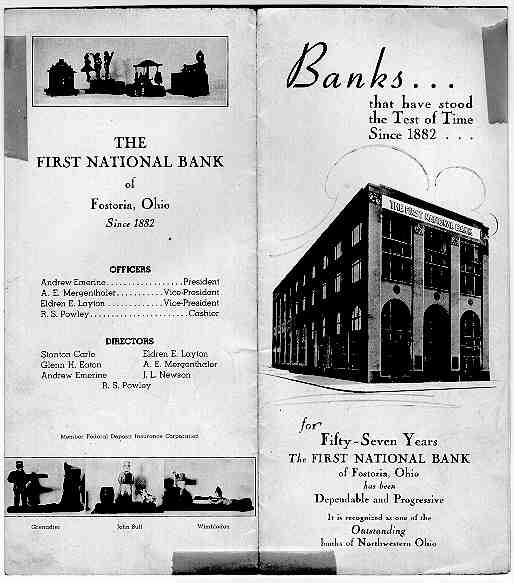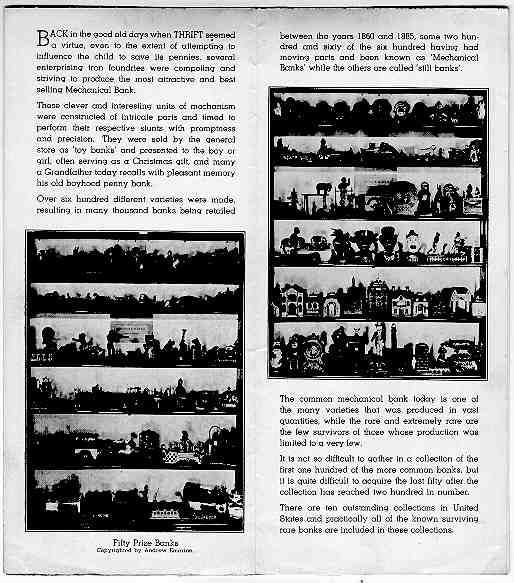That have stood
The Test of Time
Since 1882
For
Fifty-Seven Years
The FIRST NATIONAL BANK
Of Fostoria, Ohio
Has been
Dependable and Progressive
It is recognized as one of the
Outstanding
Banks of Northwestern Ohio
Back in the good old days when THRIFT seemed a virtue, even to the extent of attempting to influence the child to save its pennies, several enterprising iron foundries were competing and striving to produce the most attractive and best selling Mechanical Bank.
These clever and interesting units of mechanism were constructed of intricate parts and timed to perform their respective stunts with promptness and precision. They were sold by the general store as ‘toy banks’ and presented to the boy or girl, often serving as a Christmas gift, and many a Grandfather today recalls with pleasant memory his old boyhood penny bank.
Over six hundred different varieties were made, resulting in many thousand banks being retailed between the years 1860 and 1885, some two hundred and sixty of the six hundred having had moving parts and been known as ‘Mechanical Banks’ while the others are called ‘still banks’.
The common mechanical bank today is one of the many varieties that was produced in vast quantities, while the rare and extremely rare are the few survivors of those whose production was limited to a very few.
It is not difficult to gather in a collection of the first one hundred of the more common banks, but it is quite difficult to acquire the last fifty after the collection has reached two hundred in number.
There are ten outstanding collectors in United States and practically all the known surviving rare banks are included in these collections.
THE
FIRST NATIONAL BANK
of
Fostoria, Ohio
Since 1882
OFFICERS
Andrew Emerine………………President
E.E. Mergenthaler………..Vice-President
Eldren E. Layton……..….Vice-President
R.S. Powley…………………....Cashier
DIRECTORS
Stanton Carle Eldren E.
Layton
Glenn H. Eaton A.E. Mergenthaler
Andrew Emerine J.L. Newton
R.S. Powley
Member Federal Deposit Insurance Corporation


Text from the magazine ANTIQUES, July 1939, page 22.
ANIMATED TOYS AND
MECHANICAL BANKS
By ANDREW EMERINE
ALLIED
to the mechanical penny banks that were cherished by small fry for the last
quarter of the nineteenth century, and are today equally prized by collectors,
are key-winder toys of about the same period. The iron banks were produced by
several foundries in over two hundred different patterns varying in degree of
complexity. Some are set in motion by the mere turning of a crank; others are so
intricate as to be operated by clockworks. All, however, have one primary
function — the swallowing of pennies. The key-winder toys, on the other hand,
were designed, not to encourage habits of thrift in the young, but purely and
solely to amuse.
While cast iron enters into the construction of some, they consist for the most
part of jointed wooden figures, dressed in cloth garments. All are equipped with
clockworks, wound by a key, which put the pupped through a series of antics for
the duration of several minutes. The works are usually cased in walnut boxes of
admirably simple construction.
Of the toy characters here illustrated in conjunction with some penny banks, the
majority happens to be darkies. Probably the possibilities for animation and
caricature suggested by negro subjects appealed quite as strongly to the toy
manufactures as to the children who were eventually to wind the keys and watch
the little figures spring into lifelike and entertaining activity.
(Web note: Illustrations from a photo copy of the article
were not suitable for reproduction.)
PROCLAIM LIBERTY!
The cast-iron soldiers in the illustration below considerably antedate the
mechanical toys and banks illustrated on these pages. Carefully modeled and
appropriately garbed in painted uniforms of the style of the late 1700's, they
were probably made at some time between the Revolution and the War of 1812. The
bronze Liberty Bell whose call they have answered is a penny bank, a souvenir of
the Philadelphia Centennial Exposition of 1876. It is inscribed THE OLD
LIBERTY/BELL/PROCLAIM/1776/LIBERTY. The cannon behind the soldiers are os brass
and capable of firing an actual discharge. They are somewhat more recent than
the bell.
ULYSSES S. GRANT
The Key-winder General actually smokes a small cigar or cigarette. When the
clockworks in the box are wound, the effigy raises his left arm, bringing the
cigar holder to his lips, and inhales a full draft of smoke; then he lowers his
arm, turns his head to the left, and puffs out the smoke. The works run for five
minutes, giving him ample time to consume his weed. This toy was found in
Washington, D. C., and was probably produced in the late 1860's, during the
period of Grant's high popularity.
CONTINENTALS ON GUARD
The squad of iron soldiers, shown in the illustration above, consists of two
officers, five privates, and three cavalrymen. They stand guard here before
Philadelphia's Independence Hall, which has been reconstructed in three iron
versions, equipped to receive penny deposits. These structures, like the Liberty
Bell, are banks without mechanically operated parts.
